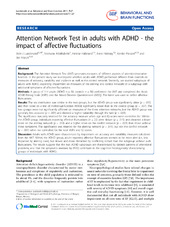| dc.contributor.author | Lundervold, Astri Johansen | |
| dc.contributor.author | Adólfsdóttir, Steinunn | |
| dc.contributor.author | Halleland, Helene Barone | |
| dc.contributor.author | Halmøy, Anne | |
| dc.contributor.author | Plessen, Kerstin von | |
| dc.contributor.author | Haavik, Jan | |
| dc.date.accessioned | 2012-01-24T11:07:33Z | |
| dc.date.available | 2012-01-24T11:07:33Z | |
| dc.date.issued | 2011-07-27 | eng |
| dc.Published | Behavioral and Brain Functions 2011, 7:27 | en |
| dc.identifier.issn | 1744-9081 | |
| dc.identifier.uri | http://hdl.handle.net/1956/5519 | |
| dc.description.abstract | Background: The Attention Network Test (ANT) generates measures of different aspects of attention/executive function. In the present study we investigated whether adults with ADHD performed different from controls on measures of accuracy, variability and vigilance as well as the control network. Secondly, we studied subgroups of adults with ADHD, expecting impairment on measures of the alerting and control networks in a subgroup with additional symptoms of affective fluctuations. Methods: A group of 114 adults (ADHD n = 58; controls n = 56) performed the ANT and completed the Adult ADHD Rating Scale (ASRS) and the Mood Disorder Questionnaire (MDQ). The latter was used to define affective fluctuations. Results: The sex distribution was similar in the two groups, but the ADHD group was significantly older (p = .005) and their score on a test of intellectual function (WASI) significantly lower than in the control group (p = .007). The two groups were not significantly different on measures of the three attention networks, but the ADHD group was generally less accurate (p = .001) and showed a higher variability through the task (p = .033). The significance was only retained for the accuracy measure when age and IQ scores were controlled for. Within the ADHD group, individuals reporting affective fluctuations (n = 22) were slower (p = .015) and obtained a lower score on the alerting network (p = .018) and a higher score on the conflict network (p = .023) than those without these symptoms. The significance was retained for the alerting network (p = .011), but not the conflict network (p = .061) when we controlled for the total ASRS and IQ scores. Discussion: Adults with ADHD were characterized by impairment on accuracy and variability measures calculated from the ANT. Within the ADHD group, adults reporting affective fluctuations seemed to be more alert (i.e., less impacted by alerting cues), but slower and more distracted by conflicting stimuli than the subgroup without such fluctuations. The results suggest that the two ADHD subgroups are characterized by distinct patterns of attentional problems, and that the symptoms assessed by MDQ contribute to the cognitive heterogeneity characterizing groups of individuals with ADHD. | en_US |
| dc.language.iso | eng | eng |
| dc.publisher | BioMed Central | eng |
| dc.rights | Attribution CC BY | eng |
| dc.rights.uri | http://creativecommons.org/licenses/by/2.0/ | eng |
| dc.title | Attention Network Test in adults with ADHD - the impact of affective fluctuations | eng |
| dc.type | Peer reviewed | |
| dc.type | Journal article | |
| dc.description.version | publishedVersion | |
| dc.rights.holder | Copyright 2011 Lundervold et al; licensee BioMed Central Ltd. | |
| dc.identifier.doi | https://doi.org/10.1186/1744-9081-7-27 | |
| dc.identifier.cristin | 848109 | |
| dc.subject.nsi | VDP::Social science: 200::Psychology: 260 | eng |

